[Ebook Việt hóa] The Unexpected Houseplant: 220 Extraordinary Choices for Every Spot in Your Home, Họ Bromeliaceae - Họ Dứa
[Ebook Việt Hoá] The Unexpected Houseplant: Bromeliads (họ Bromeliaceae, họ Dứa)
- Nguồn: [Ebook] The Unexpected Houseplant: 220 Extraordinary Choices for Every Spot in Your Home –
- Biên tập: Dũng Cá Xinh (Tháng 02/2022)
- Dịch: Team Codai.net
English
Summer
Just like gardeners everywhere, I welcome summer with open arms. In fact, like most of humanity, I warm to sunshine, the great outdoors, the hum of industrious insects, and the distant war whoops of children playing on athletic fields. With the same outrush of pent-up kinetic energy, I heave a sigh of relief when the forecasters stop harping on the F-word (frost, of course). I passionately embrace the growing season when it finally stabilizes. But I have mixed emotions.

Around here, summer means I won’t be quite so close with the houseplants. For the rest of the year, we’re intimate. We share space. I maneuver around them, and they brush against my thigh as I make my way from desk to telephone and from dinner table to front door. But with gardens galore on my property’s seven acres and plants outdoors vying for attention, my affinities and time are just as split as everyone else’s. That’s why most of my houseplants are outward bound in summer.
I miss them. I miss the constant physical contact despite the fact that, in their outdoor summer quarters, they’re just footsteps away. I suffer a sense of spatial emptiness indoors even though several favorites are kept in for sentimental reasons. But for a few months I wave a fond farewell to manipulating the sloshing watering can back and forth from the kitchen sink to the distant points in the house. With the increased sun of summer, houseplants dry out much more frequently.
And the plants are proverbial happy campers outdoors. They feel the gentle breeze rustling their leaves, which are freshened by dews and washed by sprinkles. They have ringside seats for watching the skateboarders glide by and hearing the car stereos. Or, from a less anthropomorphic view, they are street performers in the town’s comings and goings. So far, not one representative from the steady stream of joggers, dog walkers, and postal workers has swung into the driveway to pay my houseplants their compliments. But I know they’re watching. I know they’ve got their noses poised and their eyes peeled for that first promisingly plump bud on the passion flower to open.
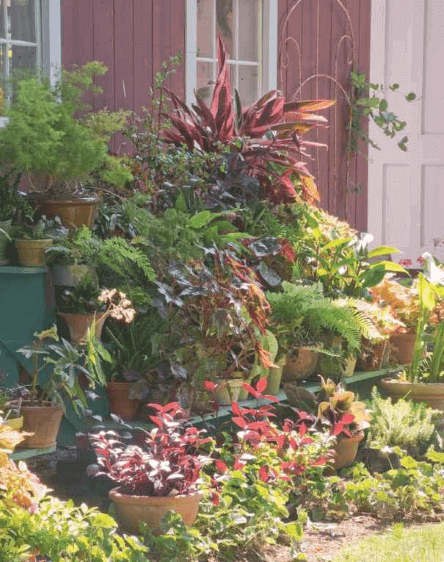
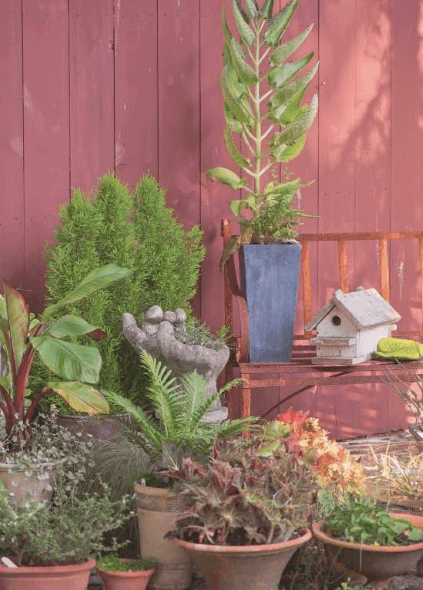
SUMMER AGENDA
Summer is a double-edged sword. Who doesn’t love the opportunity to throw open the windows and feel the warmth of the sun falling on your forehead through the panes? But summer also cranks up the chore load when ministering to container plants. That’s why most of my plants are sent outside, where the duties are divided between Mother Nature and me.
From a houseplant’s perspective, it’s like someone turned up the high beams. For plants indoors, the sun comes streaming through the windows to serve up a full dose of seething-hot wattage. Here in New England, that’s a welcome thing for light-loving plants. They bask in the bright light and add new growth galore. In the South, Southwest, and Midwest, the ramped-up solar exposure can be brutal unless it’s filtered through a curtain. Wherever you live, take a moment to assess what’s going on light-wise.
Even in New England, the story changes drastically for plants that aren’t rigged up genetically for sunbathing. Sometimes low-light lovers of the botanical kind gravitate onto south-facing windowsills. During all seasons but summer, a south-facing window usually won’t harm them. But in summer, I’ve seriously scorched orchids and African violets (even Sinningia species that come from a caudex) by forgetting to move them when the sun shifts. The moral of the story is to monitor the way sun moves into your home. No need to bring in the light meters; just eyeball the situation and move plants immediately based on the beat of the rays. But don’t hope that the plants will send out warnings before suffering from oversaturation. Scorching and foliar damage from too much sun generally happens without forewarning (although for some plants, the new growth might be disfigured or reduced in size). Fortunately, damage is generally not lethal. New, unscathed leaves will resume when you hasten the plant to a more appropriate position. But the ordeal is painful for everyone involved.
Some plants remain inside, but the bulk of my botanical collection goes outdoors. The egress isn’t haphazard. According to their light requirements, the houseplants have assigned seats. The sun-lovers are marched onto the sun-baked back patio. However, before taking up their permanent stations, they’re given a critical adjustment period. This part is important. No matter how seemingly bright their window seat was, the sun isn’t as intense as it is outside. Blasting noon sun can be a killer. In the best of all worlds, time your exodus for a rainy, cloudy spate of weather. If you can’t, protect all sun-loving plants in partial shade (or covered by cheesecloth) for the first few days when making the transition from inside to outdoors. After a few days of shade, my houseplants-on-vacation receive a parceled-out dose of sun. After a week or so of coddling, they’re finally exposed to the full brunt of noonday sunbeams.
Meanwhile, shade-tolerant plants, which constitute the bulk of my collection, go out front to lounge under the protective skirts of a massive sugar maple. By that time, the maple is fully clothed and capable of casting an expansive shadow, so no transitional intervention is needed. The same bleachers the houseplants sat on inside are moved into position outdoors to receive the crowd. Plus, dozens of indoor plants spill out the front door to form a bounteous tableau outside. I spread mine out. But you don’t need acreage to do the summer-camp thing—it can happen on your city terrace or fire escape.
All that additional light has other ramifications, as well. Watering is more of an issue in summer. Generally speaking, container plants need more frequent watering as light levels increase. When the temperatures are soaring and the sun is beating, plants with abundant foliage might need water more than once a day. In general, I minimize watering chores by selecting plants that are not drama queens. Plants that swoon after only a few hours of dry roots aren’t for me. I want to have a life.
I have no experience with soil-wetting agents because I veer toward a more natural approach to gardening. But my gut reaction is that water-retaining soil additives are not the ticket for plants that prefer to dry out between waterings, such as begonias. Similarly, I have not used drip systems because I’m based at home, and I like the intimacy and familiarity of caring for plants. But not everyone is homebound. Irrigation tubes are certainly an option, especially if you do not have a lifestyle that allows constant contact with your plants at home. Needless to say, a container must be wide enough to balance the accoutrements of drip irrigation, which brings me to container sizes and repotting.
It’s a good idea to check all your plants coming into summer to make sure they are not pot-bound. You will save yourself time and potential heartbreak. While in the process of ferrying most of my houseplants outdoors, I knock them out of their pots and check the root systems; a quick appraisal is the fastest way to diagnose a plant’s overall health, and it does absolutely no harm. When a plant’s roots have filled a container and there is little or no soil showing along the outside edges of the root ball, that plant becomes a water-monger. Every time you turn around, it is dry or wilted. Some plants can tolerate pinched toes and the resulting thirst better than others. But if the root ball is all roots and no soil, you are stressing the plant on many levels, including nutrition and moisture. And that is not a good thing.
Then again, do not overpot plants just because the growing season has arrived and the houseplants are going out to play. When you water a plant that has large expanses of excess soil without root penetration to drink up the water, the rootless soil will remain damp, and that can lead to trouble. Plus, when repotting, remember that autumn will come someday. Because I’m hosting multitudes of plants (and trying to convince you to do likewise), each one can’t be an instamatic incredible hulk (except the staghorn fern…and the agave). To maximize my space and keep every plant happy but not piggy, I give graduations of an inch or two at a time. This system has served me well.
Summer is when plants crave fertilizer. Since I go organic with fish emulsion, I fertilize every three weeks or so. That’s not sufficient for some super hungry plants, such as gardenias. But they let me know when they need food. When their leaves begin to pale from deep green to a lighter shade, dinner is served. A little sensitivity goes a long way with plants. Sometimes you have to fill custom orders in nature.
When mercury soars in summer, we wilt, but plants love it—if they receive sufficient water. I’m a fan person myself, as opposed to air-conditioning, and find that plants do not mind a light wind—in fact, they love a little breeze. Indeed, for some plants (rex begonias come to mind), stagnant air can lead to powdery mildew. Air conditioners are okay if they do not blow cold air on the plants.
This system has served me well.
Summer is when plants crave fertilizer. Since I go organic with fish emulsion, I fertilize every three weeks or so. That’s not sufficient for some super hungry plants, such as gardenias. But they let me know when they need food. When their leaves begin to pale from deep green to a lighter shade, dinner is served. A little sensitivity goes a long way with plants. Sometimes you have to fill custom orders in nature.
When mercury soars in summer, we wilt, but plants love it—if they receive sufficient water. I’m a fan person myself, as opposed to air-conditioning, and find that plants do not mind a light wind—in fact, they love a little breeze. Indeed, for some plants (rex begonias come to mind), stagnant air can lead to powdery mildew. Air conditioners are okay if they do not blow cold air on the plants.
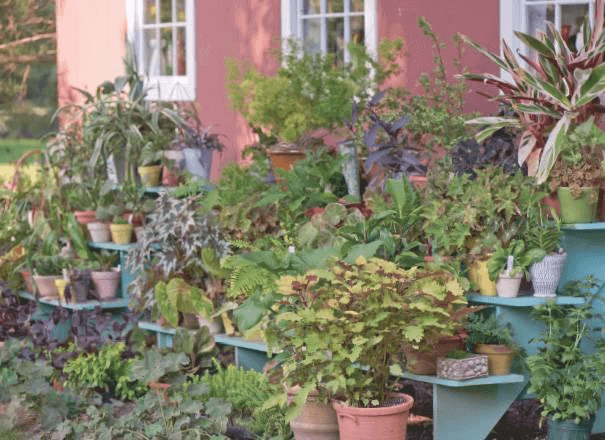
High humidity is also fine for most plants. Even succulents take it into their stride on a temporary basis. Over the long haul, it might get under their skin, but almost all houseplants can handle the occasional stifling heat-and-humidity wave.
During the summer, your plants both indoors and outside might be so delighted with the warm weather and increased sun of an open window or an outdoor location that they make new growth. When the light quality increases, plants tend to make tighter growth compared to the spindly appendages that happen in autumn and winter. If you want to keep the plant within bounds, prune back that new growth. (If you are aiming for more mass, let it grow.) Pruning also encourages a denser specimen. Prune to shape in early summer to give the plant time to make side branches and react to your input. But do not fear pruning. I am a major advocate for brandishing prune shears on a regular basis. We benefit from periodic haircuts, and so do plants.
While my houseplants are outside having fun, I do likewise. I hit the perennial borders and concentrate on the great outdoors. I know plenty of people who incorporate their plants into the garden during the growing season, and that’s brilliant. I lack the energy to run around digging up all 250 of them at summer’s end, so I leave them in their containers. And I’ve got to say, they look glorious out there.
BROMELIADS
IN THE MASS exodus that happens every summer as soon as I can send the indoor contingent out to revel on the front and back porches, some plants are held back. I need them close, but it helps if they’re low maintenance. The bromeliads have all the qualifications to remain indoors year-round. The tillandsia nests in a bowl and doesn’t jump hoops. It doesn’t grow by leaps and bounds. It’s pretty much the same today as it was three months ago. But that’s why I love it. It’s solidly, constantly, dependably, exceptionally, superlatively gorgeous.
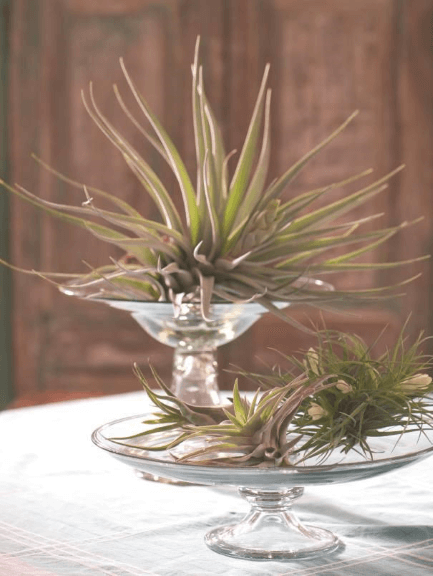
I don’t mind if a plant grows slowly, just as long as it looks great along the way. That would describe most bromeliads, the members of the pineapple family. At any stage in their maturity, they are sensational. Many have intriguing foliage, most eventually have blossoms as well, and almost all of the bromeliads in popular cultivation are ridiculously easy to host in anyone’s home.
There’s a lot of diversity in physical traits within the Bromeliaceae family. I imagine some are slackers, but members of the pineapple family tend to come up with some of the snappiest foliage in the plant world. We’re talking leaves that stem from a central rosette and are noticeably striped or spotted, bright red or silver. Some are broad, smooth, and strap-like, while others have serrated edges. Some stick straight up, while others curl around like ram’s horns. And the flowers are equally diverse. They jut from wands stacked up like rattlesnake rattlers, or they settle within a ray of surrounding leaves. The pineapple, ananas, is topped by edible fruit. So far, I’ve never met a bromeliad I didn’t like. This takes a toll on my wallet.
Depending on the time of day and the moon cycle, I am in the throes of an ardent crush on one bromeliad or another. If I fail to get this manuscript to my publisher in time, it will be because the tillandsia and I were making love. Every once in a while, I jump up to get yet one more glimpse of my Orthophytum gurkenii. (I actually carried it home from Michigan so it wouldn’t get mauled or nicked by airport security.) Or a vriesea might be my current heartthrob. Or it may be a cryptanthus. I’m fickle.
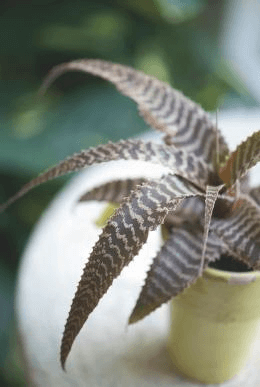
A few air plants, tillandsias, invariably remain inside over summer. If you haven’t encountered one of these sea urchin–like little wonders, you need to wrangle an introduction. They are enthralling. As the nickname implies, they need no soil. Amazingly, they can survive without being planted into any sort of growing medium. Some look like spiny little silver balls. Others have leathery, felted leaves in a Shirley Temple hairdo. They range in size from golf ball to soccer ball. Not only do I find them infinitely entertaining, but they’re so easy to host. I keep most of mine in glass jars, cups, beakers, and tureens, so I just soak them weekly for a few hours and then toss out the water. Outdoors, I tend to forget to drain off the water, with disastrous results.
The rest of the bromeliads need some sort of anchoring medium. They have long, strap-like leaves that form a vase in the center. Some are smooth, like the vrieseas. Others bare razor-sharp teeth on their edges, like the orthophytum that I (painfully) carried home by hand. Many have foliage that has absolutely outlandish markings. Vriesea hieroglyphica has wavy, irregular stripes across its brittle leaves. Vriesea gigantea has a cross-thatched web of pencil-thin lines. The aechmeas have striped leaves but add brightly colored blossoms to the brew. Neoregelias have spots or stripes going the long way up leaves that often blush cherry-red toward the center. When the leaves form a cup, such as in the aechmeas and billbergias, they love having their vase filled with water; in fact, that’s their preferred mode of drinking. But keep their moss-based medium (the preferred potting mixture) lightly moist as well. Don’t over- or underwater them, although they will endure a lot of torment before voicing displeasure.
Bright, indirect light is best for bromeliads, especially in summer. During the rest of the year, pretty much any exposure will work except north. But baking sun in summer can be stressing. By the end of the season, you might have achieved blossoms. If so, the flowering rosette will die back. Don’t take offense, don’t panic, and definitely don’t toss the plant. Although a new rosette might not be visible, it is probably poised in the wings if you’ve been giving the plant the proper care. Keep treating your bromeliad right and the replacement will become manifest. And then it’s another year of seduction and split affinities. If you thought that you were free to post blogs and check out Facebook pages without distractions, you were dead wrong.
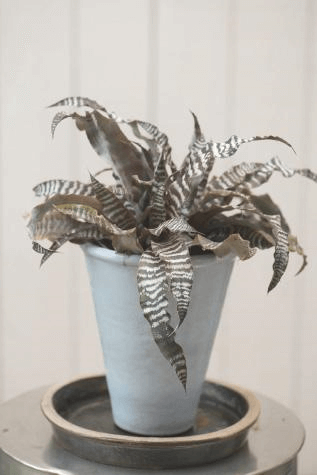
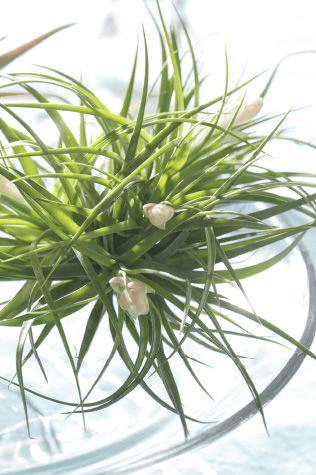
| FLOWERS | Various presentations of blooms coming from bracts or snuggled in the vase of the leaves |
| FOLIAGE | Extremely colorful and riveting in form |
| OTHER ATTRIBUTES |
Do you know of any other plants that grow on air and air alone? |
| SIZE | 2–24 inches (5–61cm) in height |
| EXPOSURE | East or west |
| WATER REQUIREMENTS |
Water when dry for most bromeliads; soak air plants once a week for a few hours |
| OPTIMUM NIGHTTIME TEMPERATURE |
55–70°F (12–21°C) |
| RATE OF GROWTH | Slow |
| SOIL TYPE | A combination of moss and wood chips works—most like an acidic soil, and air plants need no underpinning |
| FERTILIZING | Early spring to late autumn, but not critical |
| PROBLEMS | Pest-free for me, prefer not to dry out completely |
Tiếng Việt
Mùa hè
Cũng giống như những người làm vườn ở khắp mọi nơi, tôi chào đón mùa hè với vòng tay rộng mở. Trên thực tế, giống như hầu hết các loại cây, tôi rất thích ánh nắng mặt trời, ngoài trời tuyệt vời, tiếng vo ve của côn trùng siêng năng, và tiếng còi chiến xa của lũ trẻ chơi trên sân điền kinh. Với cùng một nguồn cảm hứng vui vẻ, tôi thở phào nhẹ nhõm khi các nhà dự báo thời tiết báo rằng hè đến. Tôi say mê đón nhận mùa sinh trưởng khi cuối cùng đến mùa giúp cây đã ổn định.

Xung quanh đây, mùa hè khiến tôi không gần gũi với những cây trồng trong nhà. Trong thời gian còn lại của năm thì chúng tôi lại rất thân mật. Chúng tôi chia sẻ không gian. Tôi đi qua lại xung quanh chúng và chúng cọ vào đùi tôi khi tôi đi từ bàn đến bàn làm việc để điện thoại và từ bàn ăn đến cửa trước. Nhưng với những khu vườn rộng trên 7 mẫu đất của tôi và những cây trồng ngoài trời hiện đang tranh giành sự chú ý của tôi hơn, mối quan hệ và thời gian của tôi cũng phải chia rẽ. Đó là lý do tại sao hầu hết các cây trồng trong nhà của tôi đều được ít chăm sóc hơn vào mùa hè.
Tôi nhớ chúng. Tôi nhớ những tiếp xúc cơ thể thường xuyên mặc dù thực tế là, trong khi nghỉ hè chúng chỉ cách nhau vài bước chân. Tôi có cảm giác trống trải trong không gian trong nhà mặc dù một số cây yêu thích được giữ lại vì tôi không muốn di chuyển chúng. Nhưng trong một vài tháng, tôi chào tạm biệt với việc tưới nước. Với cái nắng gay gắt của mùa hè, cây trồng trong nhà thường xuyên bị khô héo hơn nhiều.
Và thực vật là những sinh vật phát triển hơn khi ngoài trời. Chúng có thể cảm nhận được làn gió nhẹ thổi xào xạc những chiếc lá, được làm tươi mát bởi những đám sương mù và được rửa sạch bằng những chiếc vòi phun nước. Chúng ngồi bên hông để xem những người trượt ván lướt qua và nghe âm thanh trên xe hơi đi ngang qua. Hoặc, từ một góc nhìn ít nhân học hơn, chúng là những người biểu diễn đường phố trong các hoạt động thị trấn. Cho đến nay, chưa có một người chạy bộ, dắt chó đi dạo và nhân viên bưu điện nào đều đặn đi qua và để khen ngợi những chiếc cây siêu xinh trong nhà của tôi. Nhưng tôi biết chúng cũng đang dõi theo. Tôi biết chúng đã chuẩn bị sẵn sàng và bắt đầu chú ý đến những chiếc nụ đầy đặn đầy hứa hẹn đầu tiên trên bông hoa nồng nàn đang hé nở.


Đại hội Mùa hè
Mùa hè là con dao hai lưỡi. Ai lại không thích mở tung cửa sổ và cảm nhận hơi ấm của mặt trời đang rơi trên trán bạn qua những tấm kính? Nhưng mùa hè cũng làm tăng tải công việc khi chăm sóc cho cây. Đó là lý do tại sao hầu hết các cây trồng của tôi được mang ra bên ngoài, nơi mà các nhiệm vụ được phân chia giữa Mẹ Thiên nhiên và tôi.
Từ quan điểm của cây trồng trong nhà, nó giống như ai đó đã bật các thanh xà ngang lên. Đối với cây trồng trong nhà, mặt trời chiếu qua cửa sổ để tỏa ánh sáng. Ở New England đây, đó là một điều đáng hoan nghênh đối với những cây ưa sáng. Chúng đắm mình trong ánh sáng rực rỡ và thêm hàng loạt sinh trưởng mới. Ở miền Nam, Tây Nam và Trung Tây, mức phơi nhiễm năng lượng mặt trời tăng lên có thể rất tàn bạo trừ khi nó được lọc qua một tấm màn. Dù bạn sống ở đâu, hãy dành một chút thời gian để đánh giá xem ánh sáng có phù hợp không
Ngay cả ở New England, câu chuyện cũng thay đổi đáng kể đối với những loài thực vật không được chăm sóc bằng cách tắm nắng. Đôi khi những người yêu thích loại thực vật có ánh sáng yếu ở bệ cửa sổ quay mặt về hướng Nam. Trong tất cả các mùa, trừ mùa hè, cửa sổ hướng Nam thường không gây hại. Nhưng vào mùa hè, tôi đã làm cháy nghiêm trọng những cây lan và hoa violet châu Phi (thậm chí cả những loài Sinningia đến từ caudex) do quên di chuyển chúng khi mặt trời chuyển hướng. Bài học rút ra của câu chuyện là theo dõi cách mặt trời di chuyển. Không cần mang theo đồng hồ đo ánh sáng; chỉ cần quan sát tình hình và di chuyển cây ngay lập tức dựa trên nhịp của các tia. Nhưng đừng hy vọng rằng thực vật sẽ đưa ra cảnh báo trước khi bị cháy. Bệnh cháy xém và hư hại lá do quá nhiều ánh nắng mặt trời thường xảy ra mà không được báo trước (mặc dù đối với một số cây, sự phát triển mới có thể bị biến dạng hoặc giảm kích thước). May mắn thay, thiệt hại nói chung không gây chết người. Những chiếc lá mới không bị tổn thương sẽ mọc lại khi bạn để cây đến một vị trí thích hợp hơn. Nhưng điều này gây đau đớn cho cây và có thể là cả bạn.
Một số cây vẫn còn ở bên trong nhà, nhưng phần lớn bộ sưu tập thực vật của tôi lại ở ngoài trời. Theo yêu cầu ánh sáng, những chiếc cây ấy đã có chỗ ngồi hợp lí. Những loại cây yêu thích ánh nắng được diễu hành trên sân sau được sưởi nắng. Tuy nhiên, trước khi tiếp nhận ánh sáng cố định, chúng phải có một khoảng thời gian điều chỉnh. Phần này là quan trọng. Cho dù bên cửa sổ có vẻ sáng, mặt trời cũng sẽ không gay gắt như ở bên ngoài. Nắng giữa trưa có thể là một kẻ giết người. Điều tốt nhất đó là hãy dành thời gian cho việc di chuyển của bạn trong một thời tiết có mưa, nhiều mây. Nếu bạn không thể, hãy bảo vệ tất cả các cây ưa nắng trong bóng râm một phần (hoặc che bằng vải thưa) trong vài ngày đầu khi chuyển từ trong nhà ra ngoài trời. Sau một vài ngày bóng râm, những cây trồng trong nhà sẽ nhận được một lượng ánh nắng mặt trời phù hợp. Sau khoảng một tuần chăm sóc, cuối cùng chúng cũng được tiếp xúc với toàn bộ những tia nắng ban mai.
Trong khi đó, những loài thực vật chịu bóng, chiếm phần lớn trong bộ sưu tập cây của tôi, ra phía trước để nằm dài dưới lớp áo bảo vệ của một cây phong ngoài đường lớn. Vào thời điểm đó, cây phong đã được che phủ hoàn toàn và có khả năng tạo bóng rộng, vì vậy không cần can thiệp. Cũng chỗ mà những chiếc cây xinh của tôi bên trong được chuyển ra vị trí ngoài trời để đón nhận ánh sáng. Thêm vào đó, hàng chục loại cây trong nhà tràn ra cửa trước tạo thành một hoạt cảnh lộng lẫy bên ngoài. Tôi trải rộng cây ra. Nhưng bạn không cần quá nhiều diện tích để thực hiện
Tất cả ánh sáng bổ sung đó cũng có các phân nhánh khác. Tưới nước là một vấn đề quan trọng hơn trong mùa hè. Nói chung, cây trồng trong thùng chứa cần tưới nước thường xuyên hơn khi mức độ ánh sáng tăng lên. Khi nhiệt độ tăng cao và nắng gắt, những cây có tán lá rộng có thể cần nước nhiều hơn một lần một ngày. Nói chung, tôi giảm thiểu công việc tưới nước bằng cách chọn những cây không phải là những cây cần nước nhiều. Những cây héo rũ chỉ sau vài giờ rễ khô thường không phải dành cho tôi.
Tôi không có kinh nghiệm về các chất làm ướt đất bởi vì tôi hướng đến cách tiếp cận tự nhiên hơn để làm vườn. Nhưng phản ứng trực quan là các chất phụ gia giữ nước cho đất không phải là điều tốt nhất cho các loại cây thích khô héo giữa các lần tưới nước, chẳng hạn như thu hải đường. Tương tự, tôi chưa sử dụng hệ thống nhỏ giọt vì tôi đang ở nhà và tôi thích sự gần gũi và thân thuộc trong việc chăm sóc cây trồng. Nhưng không phải ai cũng hướng vậy. Ống tưới chắc chắn là một lựa chọn, đặc biệt nếu bạn không có lối sống cho phép tiếp xúc thường xuyên với cây ở nhà. Không cần phải nói, thùng chứa phải đủ rộng để cân bằng lượng nước tưới nhỏ giọt, giúp tôi đạt được kích thước thùng chứa và thay chậu.
Bạn nên kiểm tra tất cả các cây trồng của bạn sắp vào mùa hè để đảm bảo chúng không bị bó vào chậu. Bạn sẽ tiết kiệm cho mình thời gian. Trong khi đưa hầu hết các cây trồng trong nhà ra ngoài trời, tôi đưa chúng ra khỏi chậu và kiểm tra bộ rễ; đánh giá nhanh là cách nhanh nhất để chẩn đoán sức khỏe tổng thể của cây trồng và nó hoàn toàn không gây hại. Khi rễ cây đã lấp đầy thùng chứa và có rất ít hoặc không có đất lộ ra dọc theo các cạnh bên ngoài của bóng rễ, cây đó sẽ trở thành cây hút nước. Một số loài thực vật có thể chịu được rễ bị chèn ép và gây ra cơn khát nước hơn những loài khác. Nhưng nếu bóng rễ và toàn bộ rễ và không có đất, bạn đang gây áp lực cho cây ở nhiều cấp độ, bao gồm cả dinh dưỡng và độ ẩm. Và đó không phải là một điều tốt.
Sau đó, một lần nữa, đừng trồng quá nhiều cây chỉ vì mùa sinh trưởng đã đến. Khi bạn tưới nước cho cây có phần đất thừa lớn mà rễ cây không thấm nước để hút hết nước, đất không có rễ sẽ vẫn ẩm và điều đó có thể dẫn đến rắc rối. Thêm vào đó, khi thay chậu, hãy nhớ rằng một ngày nào đó mùa thu sẽ đến. Bởi vì tôi đang trồng rất nhiều loài thực vật (và cố gắng thuyết phục bạn làm như vậy), mỗi loài là một loài cây đáng kinh ngạc (ngoại trừ cây dương xỉ… và cây thùa). Để tối đa hóa không gian của tôi và giữ cho mọi cây trồng luôn tươi vui nhưng không bị lợn cợn, tôi đưa ra các mức chia độ tại một thời điểm. Hệ thống này đã phục vụ tôi rất tốt.
Mùa hè là lúc cây cối thèm phân bón. Vì tôi bón phân hữu cơ với nhũ tương cá, tôi bón phân ba tuần một lần hoặc lâu hơn. Điều đó không đủ đối với một số cây cần nhiều phân bón, chẳng hạn như cây dành dành. Nhưng chúng cho tôi biết khi nào chúng cần bón phân. Khi lá của chúng bắt đầu nhợt nhạt từ màu xanh lục đậm sang màu sáng hơn. Một chút nhạy cảm sẽ giúp ích rất nhiều cho thực vật.
Khi thủy ngân tăng cao vào mùa hè, chúng ta sẽ khó chịu, nhưng thực vật thích nó — nếu chúng nhận đủ nước. Bản thân tôi là một người hâm mộ, trái ngược với điều hòa nhiệt độ và thấy rằng thực vật không ngại gió nhẹ — thực tế, chúng thích một làn gió nhẹ. Thật vậy, đối với một số loài cây (cây thu hải đường), không khí tù đọng có thể dẫn đến bệnh phấn trắng. Máy điều hòa không khí sẽ không sao nếu chúng không thổi hơi lạnh vào cây.

Độ ẩm cao cũng tốt cho hầu hết các loại cây. Ngay cả những loài xương rồng cũng tạm thời coi đó là bước tiến . Trong một khoảng thời gian dài, nó có thể chui vào thân cây, nhưng hầu như tất cả các cây trồng trong nhà đều có thể đối phó với làn sóng nhiệt và độ ẩm không thường xuyên ngột ngạt.
Vào mùa hè, cây cối của bạn ở cả trong nhà và bên ngoài có thể rất thích thú với thời tiết ấm áp và ánh nắng nhiều hơn là của cửa sổ đang mở hoặc vị trí ngoài trời khiến chúng phát triển mạnh hơn. Khi chất lượng ánh sáng tăng lên, thực vật có xu hướng tăng trưởng chặt chẽ hơn so với phần khẳng khiu xảy ra vào mùa thu và mùa đông. Nếu bạn muốn giữ cây trong giới hạn, hãy cắt tỉa để cây phát triển mới. (Nếu bạn đang nhắm đến khối lượng lớn hơn, hãy để nó phát triển.) Cắt tỉa cũng khuyến khích mẫu vật dày đặc hơn. Tỉa tạo hình vào đầu mùa hè để cây có thời gian tạo các nhánh phụ. Đừng sợ cắt tỉa. Tôi là một người ủng hộ chính cho việc vung kéo cắt tỉa cành một cách thường xuyên. Chúng tôi được hưởng lợi từ việc cắt tỉa cành định kỳ và cây trồng cũng vậy.
Trong khi những bạn cây của tôi đang ở bên ngoài vui vẻ, tôi cũng làm như vậy. Tôi đã đạt được các biên giới lâu năm và tập trung vào hoạt động ngoài trời tuyệt vời. Tôi biết nhiều người đưa cây của họ vào vườn trong mùa sinh trưởng và điều đó thật tuyệt vời. Tôi không có năng lượng để chạy khắp nơi, để đào tất cả 250 trong số chúng vào cuối mùa hè, vì vậy tôi để chúng trong thùng chứa. Và tôi phải nói rằng, ngoài kia trông chúng rất rực rỡ.
Cây Dứa Cảnh
TRONG cuộc di cư MASS diễn ra vào mùa hè hàng năm ngay khi tôi có thể gửi nhữngchậu cây trong nhà ra ngoài để vui chơi trên hiên trước và sau, một số cây trồng đã bị kìm hãm. Tôi cần cất chúng vào nhà, nhưng sẽ hữu ích nếu chúng là những cây ít cần chăm sóc. Các cây dứa cảnh có tất cả các điều kiện để ở trong nhà quanh năm. Tillandsia phát triển trong một cái bát. Nó không phát triển một cách nhanh chóng. Hôm nay khá giống với ba tháng trước. Nhưng đó là lý do tại sao tôi thích nó. Nó chắc chắn, liên tục, đáng tin cậy, đặc biệt, cực kỳ lộng lẫy.

I don’t mind if a plant grows slowly, just as long as it looks great along the way. That would describe most bromeliads, the members of the pineapple family. At any stage in their maturity, they are sensational. Many have intriguing foliage, most eventually have blossoms as well, and almost all of the bromeliads in popular cultivation are ridiculously easy to host in anyone’s home.
There’s a lot of diversity in physical traits within the Bromeliaceae family. I imagine some are slackers, but members of the pineapple family tend to come up with some of the snappiest foliage in the plant world. We’re talking leaves that stem from a central rosette and are noticeably striped or spotted, bright red or silver. Some are broad, smooth, and strap-like, while others have serrated edges. Some stick straight up, while others curl around like ram’s horns. And the flowers are equally diverse. They jut from wands stacked up like rattlesnake rattlers, or they settle within a ray of surrounding leaves. The pineapple, ananas, is topped by edible fruit. So far, I’ve never met a bromeliad I didn’t like. This takes a toll on my wallet.
Depending on the time of day and the moon cycle, I am in the throes of an ardent crush on one bromeliad or another. If I fail to get this manuscript to my publisher in time, it will be because the tillandsia and I were making love. Every once in a while, I jump up to get yet one more glimpse of my Orthophytum gurkenii. (I actually carried it home from Michigan so it wouldn’t get mauled or nicked by airport security.) Or a vriesea might be my current heartthrob. Or it may be a cryptanthus. I’m fickle.

Một vài cây không khí, tillandsias, luôn tồn tại bên trong nhà qua mùa hè. Nếu bạn chưa gặp một trong những kỳ quan nhỏ giống như loài cây “nhím biển” này, bạn cần phải tìm hiểu ngay. Chúng vô cùng đẹp. Như biệt danh của chúng, chúng không cần đất. Thật ngạc nhiên, chúng có thể sống sót mà không cần trồng vào bất kỳ loại chất trồng nào. Một số trông giống như những quả bóng bạc nhỏ có gai. Những loại cây khác có những chiếc lá bằng da, bọc nỉ trong kiểu tóc của Shirley Temple. Chúng có nhiều kích cỡ từ bóng gôn đến bóng đá. Tôi không chỉ thấy chúng vô cùng thú vị mà còn rất dễ sắp xếp. Tôi giữ hầu hết trong lọ thủy tinh, cốc, và liureens, vì vậy tôi chỉ cần ngâm chúng hàng tuần trong vài giờ và sau đó đổ ra nước.
Phần còn lại của các cây dứa là cần một số loại môi trường neo. Chúng có những chiếc lá dài, giống như dây đeo tạo thành một chiếc bình ở trung tâm. Một số lại mịn, như vrieseas. Những cây khác để lại những chiếc răng sắc như dao cạo trên mép, giống như một số loại cây mà tôi (đau đớn) mang về nhà bằng tay. Nhiều cây có tán lá hoàn toàn kỳ dị. Vriesea hieroglyphica có các sọc lượn sóng, không đều trên những chiếc lá giòn của nó. Vriesea gigantea có một mạng lưới hình chữ thập gồm các đường mảnh như bút chì. Aechmeas có lá sọc nhưng có thêm những bông hoa màu sắc rực rỡ để ủ rượu. Neoregelias có các đốm hoặc sọc dọc theo chiều dài lên lá thường có màu đỏ anh đào về phía trung tâm lá. Khi những chiếc lá tạo thành một chiếc cốc, chẳng hạn như trong cây sồi và cây lá ngón, chúng thích đầy nước; trên thực tế, đó là chế độ tưới nước ưa thích của họ. Nhưng cũng nên giữ cho giá thể gốc rêu (hỗn hợp bầu ưa thích) ẩm nhẹ. Đừng làm quá hoặc làm tưới quá nhiều nước, mặc dù chúng sẽ phải chịu đựng rất nhiều trước khi thể hiện sự không hài lòng.
Ánh sáng gián tiếp, sáng sủa là tốt nhất cho dứa cảnh, đặc biệt là vào mùa hè. Trong thời gian còn lại của năm, hầu hết mọi tiếp xúc sẽ hoạt động ngoại trừ hướng bắc. Nhưng nắng cháy vào mùa hè có thể gây căng thẳng. Vào cuối mùa, bạn có thể đã đạt được những bông hoa. Mặc dù có thể không nhìn thấy một bông hoa mới, nhưng nó có thể đã sẵn sàng nở nếu bạn chăm sóc cây đúng cách. Tiếp tục chăm sóc cây dứa cảnh của bạn đúng cách và việc nở hpa sẽ trở nên rõ ràng.


| HOA | Các hình thức trình bày khác nhau của hoa nở ra từ lá hoặc nằm gọn trong bình lá |
| TÁN LÁ | Cực kỳ nhiều màu sắc |
| THUỘC TÍNH KHÁC | Bạn còn biết loại cây nào khác mọc trên không và không khí không? |
| KÍCH THƯỚC | Chiều cao khoảng 5 – 61cm |
| VỊ TRÍ ĐỂ | Đông hoặc Tây |
| YÊU CẦU TƯỚI NƯỚC | Tưới nước khi khô đối với hầu hết các bromeliad; ngâm cây không khí mỗi tuần một lần trong vài giờ |
| NHIỆT ĐỘ TỐI ƯU VÀO BAN ĐÊM | 12 – 21°C |
| TỈ LỆ TĂNG TRƯỞNG | Chậm |
| LOẠI ĐẤT | Sự kết hợp giữa rêu và gỗ vụn có tác dụng — hầu hết giống như đất chua và cây này không cần lớp nền |
| BÓN PHÂN | Đầu mùa xuân đến cuối mùa thu, nhưng không quan trọng |
| CÁC VẤN ĐỀ | Đối với tôi không có sâu bệnh, không muốn đất khô hoàn toàn |
![[Ebook Việt Hoá] The Unexpected Houseplant: Bromeliads (họ Bromeliaceae, họ Dứa) [Ebook Việt Hoá] The Unexpected Houseplant: Bromeliads (họ Bromeliaceae, họ Dứa)](https://vn1.vdrive.vn/codai.net/2021/02/ebook-viet-hoa-220-lua-chon-cay-canh-trong-nha-selaginellas-1.jpg)


